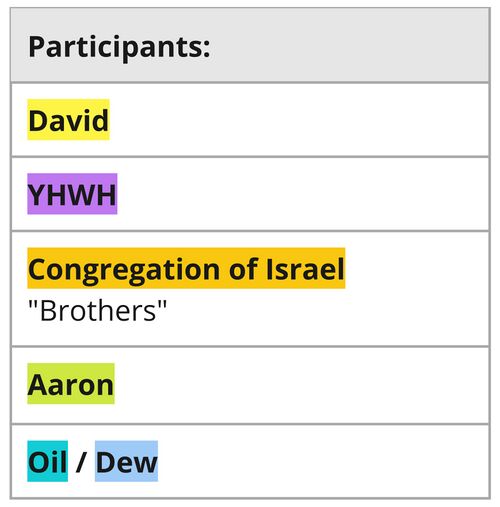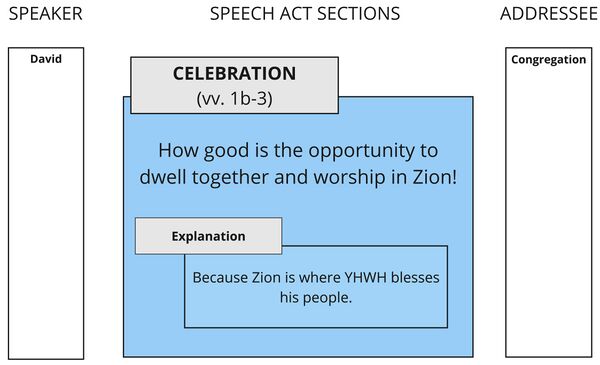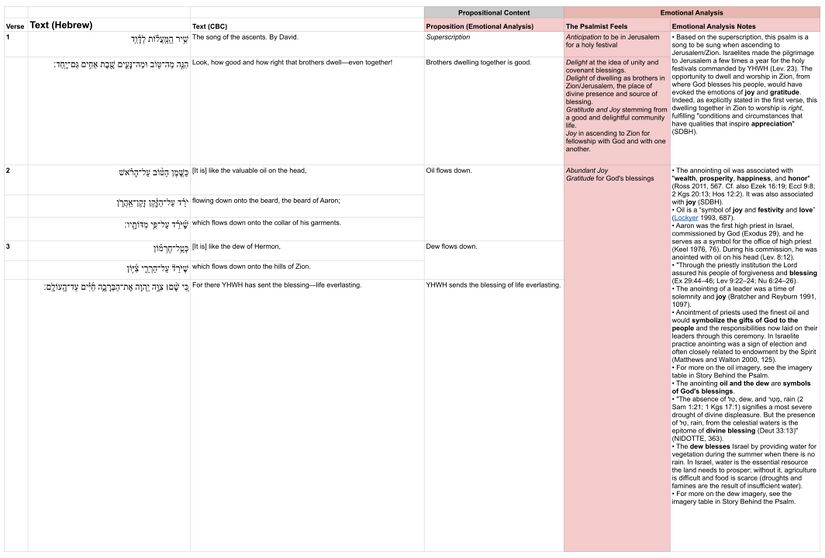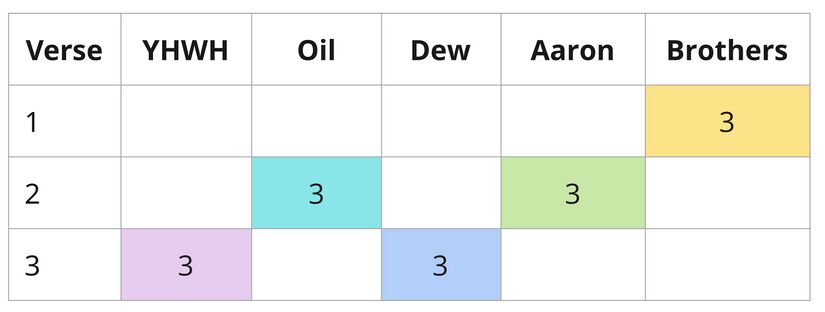Psalm 133 Discourse
About the Discourse Layer
Our Discourse layer includes four analyses: macrosyntax, speech act analysis, emotional analysis, and participant analysis. (For more information, click 'Expand' to the right.)
Macrosyntax
The macrosyntax layer rests on the belief that human communicators desire their addressees to receive a coherent picture of their message and will cooperatively provide clues to lead the addressee into a correct understanding. So, in the case of macrosyntax of the Psalms, the psalmist has explicitly left syntactic clues for the reader regarding the discourse structure of the entire psalm. Here we aim to account for the function of these elements, including the identification of conjunctions which either coordinate or subordinate entire clauses (as the analysis of coordinated individual phrases is carried out at the phrase-level semantics layer), vocatives, other discourse markers, direct speech, and clausal word order.
For a detailed explanation of our method, see the Macrosyntax Creator Guidelines.
Speech Act Analysis
The Speech Act layer presents the text in terms of what it does, following the findings of Speech Act Theory. It builds on the recognition that there is more to communication than the exchange of propositions. Speech act analysis is particularly important when communicating cross-culturally, and lack of understanding can lead to serious misunderstandings, since the ways languages and cultures perform speech acts varies widely.
For a detailed explanation of our method, see the Speech Act Analysis Creator Guidelines.
Emotional Analysis
This layer explores the emotional dimension of the biblical text and seeks to uncover the clues within the text itself that are part of the communicative intent of its author. The goal of this analysis is to chart the basic emotional tone and/or progression of the psalm.
For a detailed explanation of our method, see the Emotional Analysis Creator Guidelines.
Participant Analysis
Participant Analysis focuses on the characters in the psalm and asks, “Who are the main participants (or characters) in this psalm, and what are they saying or doing? It is often helpful for understanding literary structure, speaker identification, etc.
For a detailed explanation of our method, see the Participant Analysis Creator Guidelines.
Discourse Visuals for Psalm 133
Macrosyntax
Notes
Discourse Discontinuities
- The discourse unit of vv. 1b-3a is delimited by the deictic particle הִנֵּה (for which, see the grammar notes) and the following similes.
- The delimitation of v. 3b-c is signaled by the discourse-function כִּי, which grounds the preceding discourse of the psalm (see the exegetic issue, The Function and Scope of כִּי in Psalm133:3).
Constituent focus
- Although יָֽחַד is found at the end of the clause, it is preceded by the focus particle גַּם, making transparent its function as scalar focus (see "even" in the CBC and the discussion in the grammar notes, as well as the exegetical issue, The Meaning of שֶׁבֶת אַחִים גַּם יָחַד in Psalm133:1.
- The fronting of שָׁ֨ם׀ within its clause signals its function as selective focus, as illustrated by the cleft-structure in English: "it is there that..." (cf. CEB, CJB, DHH, NBS, NET, NFC, PDV, SG21). As selective focus, it necessarily eliminates other possible locations of where YHWH may have sent the blessing.
Speech Act Analysis
Summary Visual
Speech Act Chart
Notes
- The psalm's global speech act is a celebration of the good and delightful experience of brothers dwelling together in Zion, the place of divine presence and source of blessing. As Allen notes, the psalm celebrates "the gathering of Judean pilgrims in Jerusalem to worship at festival time. The crowds in the holy city were a beautiful perspective of Israelite community, bound together not only by nationhood but by covenant relationship as God’s family."[1]
- The psalm speaks "of the uniting of the people of all parts of the land for the purpose of divine worship in the one place of the sanctuary."[2]
Emotional Analysis
Summary visual
Emotional Analysis Chart
Participant analysis
There are 5 participants/characters in Psalm 133:

- As "member[s] of same family, clan, tribe, or ethnic group"[3], brothers (אַחִים) most likely refers to the twelve brothers of Israel, from whom the twelve tribes descended, so representing all the families of Israel. Hence, "brothers" are not necessarily biological brothers, but rather a way to denote the extended family/the entire congregation of Israel. In the context of this psalm, these are the pilgrims who have been traveling to Jerusalem for a holy festival.
- Oil and Dew: Though not exactly participants per se, these two liquids play a prominent role in this psalm. They are used for comparison to the pleasantness of the congregation's unity, and they display the heart of the psalm's message.
- Aaron: The first high priest of the people of Israel. Here, he is not an active participant, but rather is used as a symbol for the priesthood.
Participant Relations Diagram
The relationships among the participants may be abstracted and summarized as follows:


Participant Analysis Table
Notes
- v. 2c: oil or beard?
- The grammar is ambiguous as to whether it is the oil that is flowing down onto Aaron's garments, or if it's the beard. The evidence strongly points to the oil, however. For a full discussion see the exegetical issue: The Antecedent of שֶׁיֹּרֵד in Psalm133:2.
- Addressee - Congregation of Israel
- Although the psalm does not specify any addressee, it is probable that the congregation of Israel would be the assumed addressee. The reference to "brothers" in v. 1 and the placement of this psalm within the Psalms of Ascent support the congregation of Israel as the assumed addressee.
Participant Analysis Summary Distribution
Notes
- Brothers are explicitly mentioned in v. 1. Then, in vv. 2 and 3, they are elided subjects. Moreover, the brothers' harmonious community life is compared to both the dew of Hermon and the anointing oil used in Aaron's consecration. In v. 3, YHWH appears as the one who has sent the blessing of life everlasting to the brothers (implied).
Bibliography
- Allen, Leslie. 2002. Psalms 101-150. Vol. 3. Word Biblical Commentary 21. Revised edition. Waco: Word Books.
- Delitzsch, Franz. 1877. Biblical Commentary on the Psalms: Vol. 3. Edinburgh: T&T Clark.





